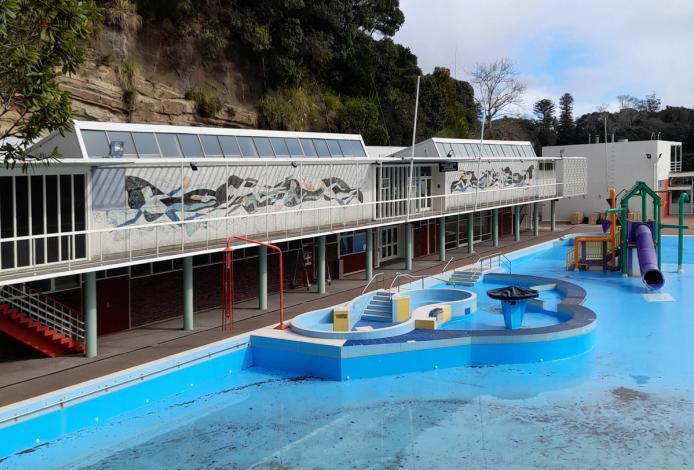James Turkington
b. 1895d. 1979
Also known as:
- Jim Turkington
5 Artworks
James Turkington was one of Aotearoa’s most prolific mural artists. Born in Ireland, he came to New Zealand with his parents in 1897, the family settling in Pukerau, near Gore. From 1912-1913 he attended Wellington Technical College, studying under Linley Richardson. During the war Turkington joined the army, serving as a lead gun driver. On his return to Aotearoa he undertook further art training at the University of Auckland, Elam School of Fine Art, before working with Chandler & Co, a sign-writing and advertising company. There he produced large-scale billboards and cinema facades.
Between 1925 and 1938 he worked at the University of Auckland as Lettering and Design Tutor at Elam, later becoming a Senior Lecturer. At other times he would also teach in the School of Architecture, and the Auckland Society of Arts. He was an active member of the Society, both exhibiting and serving as a Board Member and President from 1959 to 1963.
Mural work became a large part of his life during the turbulent years of the Great Depression up to the 1960s. During the Queen St Riot of April 1932 Turkington recalled he was painting the interior of a shop and could hear the windows breaking outside.
By the early 1940’s Turkington’s murals encompassed a range of different techniques, including low and mid-relief scenes carved into materials like soft-board and stone. The works would be painted to add depth or further highlights to the textured areas. In the mid-1940’s Turkington was often employed by Freddie Maeder to design and paint interiors for his expanding hair salon business, initially through Aotearoa and then in Australia during the 50’s and 60’s. Another long-term client was liquor entrepreneur Henry Kelliher. As the Kelliher empire expanded, Turkington was often employed to design and paint large-scale works for hotels throughout the country, and to design details right down to the menu cards.
From 1960-61 he worked for Formica as Senior Artist in Art Division, despite being old enough to collect a pension. Here he teamed up with Formica to pioneer a new process that aimed to increase the lifespan of murals and make them more portable. Described by Turkington in Building Progress as like the fabrication of Formica, where layers of coloured and printed resin coated kraft paper were laminated together as a durable surface.
Sadly, although Turkington created hundreds of works in almost every town in Aotearoa, many have been destroyed, or plastered and painted over. Others may yet exist, hidden behind walls. Remaining public works include those at the Parnell Pools, Auckland (1957), glass works at the Devonport Naval Base (1958), the 'Wahine' work now at Wellington Museum, and a mural for the Rotorua Land Court building (circa 1963).
See also:

James Turkington, ‘Parnell Baths’ (1957), Judges Bay, Parnell, Tāmaki Makaurau Auckland
Image: Bronwyn Holloway-Smith, Public Art Heritage Aotearoa New Zealand, 2021

![Untitled [Parnell Baths]](/_next/image?url=https%3A%2F%2Fcdn.sanity.io%2Fimages%2Faem3610x%2Fproduction%2Fd9c570000a6691d729d50166088191785f63cd98-1596x1080.jpg%3Frect%3D258%2C0%2C1080%2C1080%26w%3D330%26h%3D330%26fit%3Dclip&w=750&q=75)
![Untitled [New Plymouth Post Office]](/_next/image?url=https%3A%2F%2Fcdn.sanity.io%2Fimages%2Faem3610x%2Fproduction%2F29b367023101f48a48b3ee3d4801b62036ece909-648x1080.jpg%3Frect%3D0%2C216%2C648%2C648%26w%3D330%26h%3D330%26fit%3Dclip&w=750&q=75)
![Untitled [Māori Land Court Foyer]](/_next/image?url=https%3A%2F%2Fcdn.sanity.io%2Fimages%2Faem3610x%2Fproduction%2Ffb2ff32376037382711837a91e3da4e123648a0e-1080x1080.jpg%3Fw%3D330%26h%3D330%26fit%3Dclip&w=750&q=75)
![Untitled [Maori Land Court Doors]](/_next/image?url=https%3A%2F%2Fcdn.sanity.io%2Fimages%2Faem3610x%2Fproduction%2F7352b933e3bd02b0190e561bced6cb8894a6c1f7-842x1080.jpg%3Frect%3D0%2C119%2C842%2C842%26w%3D330%26h%3D330%26fit%3Dclip&w=750&q=75)
![Untitled [ASB Devonport]](/_next/image?url=https%3A%2F%2Fcdn.sanity.io%2Fimages%2Faem3610x%2Fproduction%2F8fd3c42d2e2a0e5a9d4d96edcd0a5f5d56f87183-2373x2376.jpg%3Frect%3D0%2C2%2C2373%2C2373%26w%3D330%26h%3D330%26fit%3Dclip&w=750&q=75)